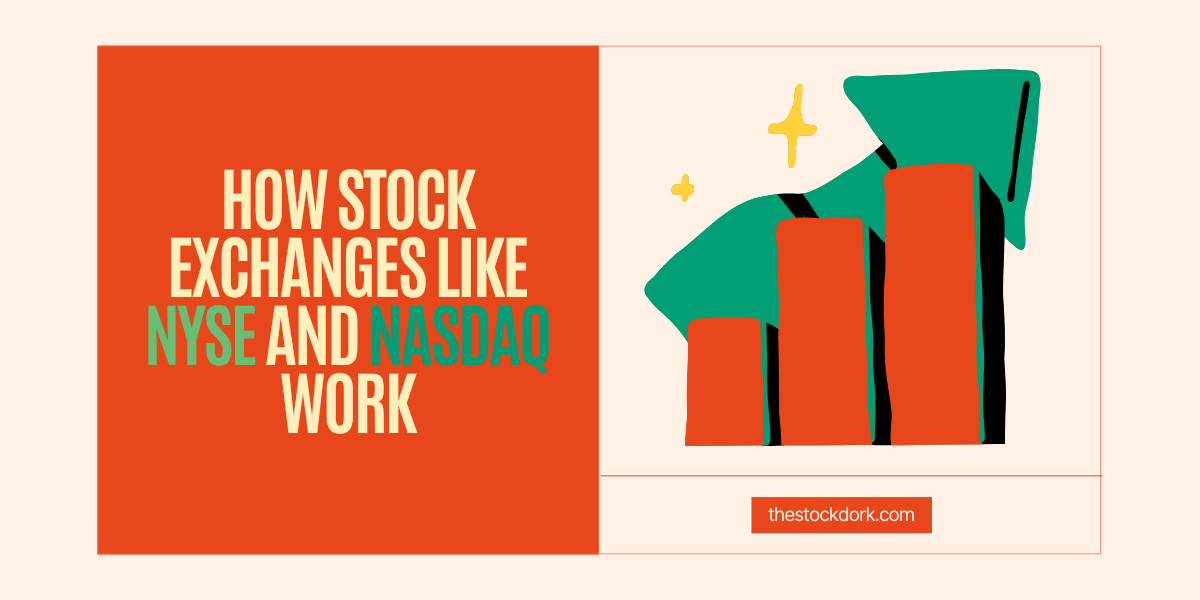If you have ever wondered how the stock market really works, you are not alone. Many new investors hear about the New York Stock Exchange (NYSE) or the NASDAQ Stock Exchange without fully knowing what happens behind those names. Understanding how stock exchanges work is one of the best ways to gain confidence after early investing losses. Once you see how the system functions, investing starts to feel less like guessing and more like making informed choices.
What a Stock Exchange Actually Is
A stock exchange is a structured marketplace where people buy and sell ownership in real companies. Each piece of ownership is called a share, or a stock. When you buy a share, you own a small part of that company. If the company earns profits and grows, your shares may rise in value.
Many people use the terms “stock market” and “stock exchange” as if they mean the same thing, but they are slightly different.
The stock market is the overall network of all the exchanges where buying and selling take place. The stock exchange is a specific place, either physical or digital, where those trades actually happen.
The NYSE and NASDAQ are the two main exchanges in the United States. They connect millions of investors every day, helping money move to where it can do the most good for the economy.
Why Stock Exchanges Exist
Stock exchanges exist to connect two groups that need each other. Companies want to raise money to grow, and investors want opportunities to build wealth.
Instead of borrowing from banks, a company can sell shares to the public through an event called an Initial Public Offering, often shortened to IPO. When you buy those shares, the company receives money to expand, and you become part owner.
After the IPO, shares continue to trade every day between investors. The company does not receive money from these later trades, but investors can buy or sell their ownership whenever they choose.
This constant trading gives the market something called liquidity, which simply means that people can quickly turn shares into cash or cash into shares when they need to.
How Stock Exchanges Work Day to Day
Every trade you make goes through a precise process. When you decide to buy a stock through your brokerage app, your order travels electronically to one of the main exchanges.
There, it enters a digital system called an order book matching engine. This engine is a program that compares all buy and sell orders and finds matches between them.
Imagine a giant, fast-moving queue of buyers and sellers, all placing their offers at different prices. The matching engine pairs them up based on who is offering the best price at that moment.
Once it finds a match, the trade takes place almost instantaneously.
The shares then move to your account, the money goes to the seller, and the transaction is recorded permanently. Amazingly, this process happens countless times each minute as shares move back and forth.
How the New York Stock Exchange Works
The New York Stock Exchange is, for many people, the quintessential picture of Wall Street. It was founded in 1792 and still operates from its historic building in New York City.
As the world’s largest exchange by market value, it lists more than 2,000 companies, including names like Coca-Cola, JPMorgan Chase, and ExxonMobil.
The NYSE serves primarily as an auction market, meaning buyers and sellers bid against each other to find a fair price.
Both people and automated systems facilitate this process, with professionals called Designated Market Makers overseeing trading for specific companies.
Their job is to make sure that trades happen smoothly and that prices do not swing wildly when markets get emotional.
How the NASDAQ Works
The NASDAQ began in 1971 as the world’s first fully electronic stock exchange. Void of any trading floor, all trades happen through a network of computers and professional participants called market makers.
A market maker is a firm that continuously offers to buy and sell stocks at quoted prices. Their role is to keep trading active and ensure that there is always someone available to take the other side of a trade.
If you buy shares of companies like Apple, Microsoft, or Tesla, your order likely goes through the NASDAQ. The system finds another investor or market maker ready to sell at your chosen price.
This setup makes the NASDAQ a dealer market, which is different from the NYSE’s auction style.
Understanding the Difference Between NYSE and NASDAQ
These two major U.S. exchanges feature a few major differences that make each one stand out in a unique way.
The NYSE relies on human specialists alongside technology to manage trading, while NASDAQ operates entirely through computers and dealers. The NYSE lists many large, established companies, while NASDAQ is known for tech-focused and fast-growing firms.
Both are heavily regulated by the U.S. Securities and Exchange Commission (SEC), to ensure fairness, transparency, and investor protection. Whether you trade on one or the other, your money moves through a system that prioritizes accuracy and safety.
What Happens When You Buy a Stock
If you have ever wondered what happens when you buy a stock on the
Purchasing stock on the NYSE or NASDAQ is actually quite straightforward. You decide what company you want to own, enter your order, and your broker sends it to the exchange. The exchange finds a seller at the same price, matches the trade, and sends a confirmation back to your account.
Behind the scenes, a clearing organization makes sure that the money and shares change hands correctly. This process, known as clearing and settlement, usually finishes within two business days. The result is ownership of your chosen company recorded in your brokerage account.
How Companies Qualify to Be Listed
Not every business can appear on a major exchange. To protect investors, each exchange has a set of rules called listing requirements.
The listing requirements for the NYSE include minimum levels of income, market value, and number of shareholders, whereas the NASDAQ’s qualifications are slightly more flexible, making it attractive to younger, high-growth companies.
Having these standards ensures that only credible, transparent, and financially stable companies reach the public market.
Why There Are Different Stock Exchanges
It might seem odd that there are multiple exchanges when they serve a similar purpose, but the reason is competition. Each exchange offers different technology, listing benefits, and trading structures.
This variety encourages innovation and keeps costs lower for both investors and companies.
You can think of exchanges like schools in the same city. They follow the same education laws, but may teach with slightly different styles.
Having more than one exchange gives companies and investors a choice in how they participate in the market.
Trading Hours and Market Access
Surprisingly, these major stock exchanges are not open 24 hours per day. Both the NYSE and NASDAQ operate during set hours, from 9:30 a.m. to 4:00 p.m. Eastern Time, Monday through Friday.
There are sessions before and after those times for electronic trades, but those periods are less active and can be more volatile.
Understanding these hours helps you plan when to place your orders and also reminds you that investing is meant to happen over time, not minute by minute.
Seeing the Market as a Whole
Once you understand the moving parts, the stock market starts to look less like chaos and more like a coordinated machine.
Each exchange, each trade, and each investor plays a role in helping money move to its most productive use. Companies get the funds to innovate, while investors share in their potential success.
If you have faced losses before, this perspective helps. Those moments of loss are not failures of the system but normal parts of investing. Markets move in cycles, and over time, knowledge and patience make the difference.
Bringing It All Together
Stock exchanges have their complexities, but this deeper dive into how they work can shed light on the hope of wealth generation that so many investors pursue.
Simply understanding why there are different exchanges and how they each work can help you trade better and diversify your portfolio in new ways.
Most importantly, you can see that the stock market is not a mysterious place, but a well-organized network built to serve both businesses and investors. Every order, every price, and every match follows a system that has been refined over centuries to keep trust at its center.




 Tags:
Tags:










